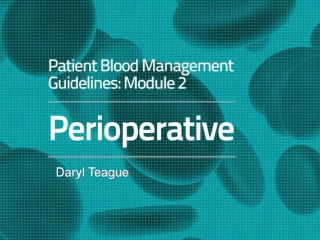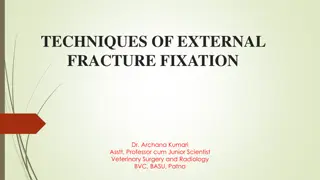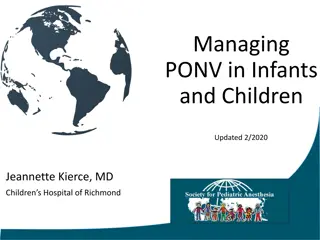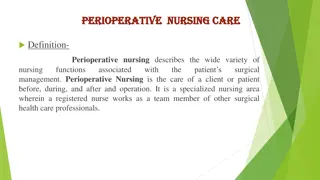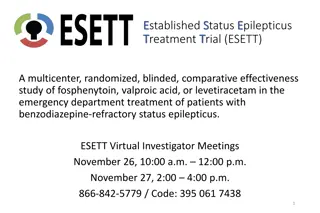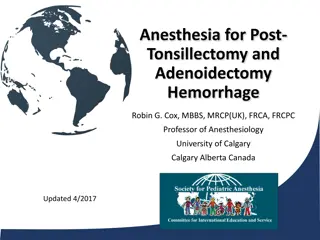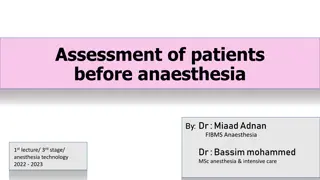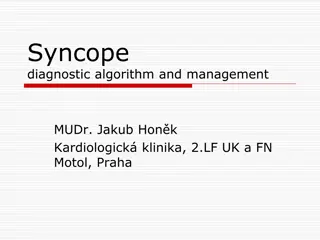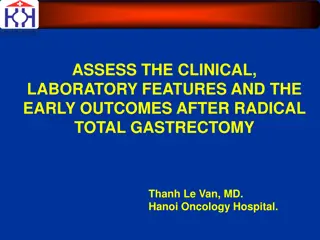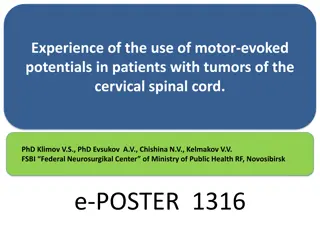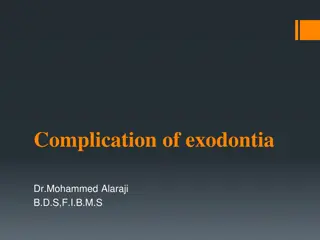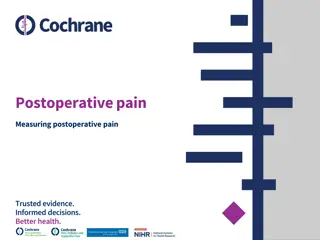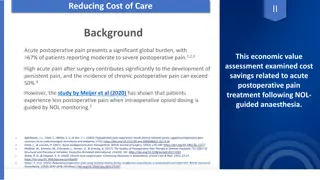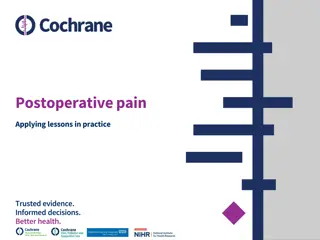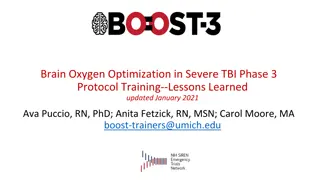Perioperative Patient Blood Management
The Patient Blood Management (PBM) Program implemented by Orthopaedic Surgeon Daryl Teague to provide optimal care for Ruby, a 73-year-old with diabetes and high blood pressure, who needs a new hip joint. The program includes preoperative anemia assessment, intraoperative blood conservation, and pos
2 views • 20 slides
DrEaMing CQUIN update for 23/24
Importance of implementing Enhanced Recovery after Surgery (ERAS) protocols to improve patient outcomes following major surgical procedures. It covers the benefits of early mobilization, fluid optimization, and proper analgesia techniques. By emphasizing early postoperative activities like drinking,
0 views • 14 slides
Understanding Shock: Causes, Symptoms, and Stages
Shock is a critical condition caused by an imbalance between cellular oxygen supply and demand, leading to organ dysfunction. Compensatory responses include increased heart rate, vasoconstriction, and hormonal adjustments. Recognizable features of shock include tachycardia, hypotension, cool clammy
3 views • 27 slides
Anesthesia and Perioperative Care - Comprehensive Guide by Dr. Rajesh Raman
This detailed guide by Dr. Rajesh Raman covers various aspects of anesthesia and perioperative care, including preoperative assessment and optimization, intraoperative care, postoperative care, perioperative risk assessment, risk due to surgery, medication management, and routine investigations for
2 views • 31 slides
Understanding Coronary Artery Bypass Graft (CABG) in Adult Nursing
Coronary Artery Bypass Graft (CABG) is a surgical procedure where a blood vessel from another part of the body is grafted onto an occluded coronary artery to bypass blockages. This procedure is less common in women compared to men and is typically indicated for severe coronary artery disease. It is
5 views • 15 slides
Anesthesia And Perioperative Care
This detailed guide covers key aspects of anesthesia and perioperative care, emphasizing preoperative assessment, optimization, intraoperative management, and postoperative care. Topics include perioperative risk assessment, risk scoring, routine investigations, and medication management strategies
1 views • 31 slides
Anesthesia and Perioperative Care by Dr. Rajesh Raman
This informative content covers various aspects of anesthesia and perioperative care including preoperative assessment, optimization, intraoperative and postoperative care, perioperative risk assessment, risk due to surgery, risk scores for major cardiac events, routine investigations for patients,
0 views • 31 slides
Anesthetic Management of Bronchoscopy for Airway Foreign Body
This article discusses the anesthetic management of bronchoscopy for airway foreign body, including presentation, preoperative work-up, intraoperative management, and postoperative care. It highlights the incidence of foreign body inhalation, immediate and delayed presentations, findings on chest X-
2 views • 32 slides
Techniques of External Fracture Fixation in Veterinary Surgery
Dr. Archana Kumari, Asst. Professor and Junior Scientist in Veterinary Surgery and Radiology, presents various methods of external fracture fixation such as Robert Jones bandage, Ehmer sling, plaster cast, Thomas splints, walking cast, and hanging pin cast. The walking cast is indicated for fracture
1 views • 22 slides
Managing Postoperative Nausea and Vomiting in Infants and Children
Postoperative nausea and vomiting (PONV) is a significant concern in pediatric patients due to their increased risk compared to adults. This presentation by Dr. Jeannette Kierce covers the pathophysiology, risk factors, prophylaxis, and rescue treatments for PONV in infants and children, emphasizing
0 views • 34 slides
Understanding Ward Management in Healthcare Settings
Ward management involves optimizing resources in a ward to provide maximum care and comfort to patients. It includes functions like accommodation, treatment, recovery support, training opportunities, and research possibilities. Different types of wards exist, such as general wards and specific wards
2 views • 25 slides
Essential Aspects of Perioperative Nursing Care
Perioperative nursing involves comprehensive care for patients before, during, and after surgery. It encompasses various phases such as preoperative, intraoperative, and postoperative care, with a focus on ensuring the patient's well-being and safety throughout the surgical process. Key goals includ
0 views • 33 slides
Preoperative Planning for Surgery: Optimizing Patient Outcomes
Major surgery can induce physiological changes, increasing oxygen demand and leading to postoperative risks. Careful preoperative planning is crucial to minimize adverse effects. This involves thorough history-taking, examination, and investigations to assess patient readiness and optimize their con
0 views • 35 slides
Comparative Effectiveness Study of Second-Line Agents in Status Epilepticus Treatment: ESETT Trial
Comparative effectiveness study known as ESETT Trial aims to determine the most effective second-line agent for treating benzodiazepine-refractory status epilepticus in emergency departments. Fosphenytoin, valproic acid, and levetiracetam are common choices, but the best option remains uncertain. Th
0 views • 48 slides
Autologous Blood Donation: Advantages, Types, and Considerations
Autologous blood donation involves collecting and storing a patient's own blood for later transfusion, offering numerous advantages such as reducing the risk of transfusion-transmitted diseases and providing compatible blood for patients with allo-antibodies. However, it also comes with concerns lik
1 views • 46 slides
Association of Renal and Cerebral Near Infrared Spectroscopy with Low Cardiac Output in Single Ventricle Patients
Near-infrared spectroscopy (NIRS) has been studied in infants after Stage I palliation surgery to assess its association with low cardiac output and adverse outcomes. This retrospective study investigated postoperative cerebral and renal NIRS values in infants with single ventricle physiology. Resul
0 views • 13 slides
Anesthesia Management for Post-Tonsillectomy Hemorrhage in Children
This article discusses the epidemiology, causes, and anesthesia management of post-tonsillectomy and adenoidectomy hemorrhage in children. It covers the rates of hemorrhage following these procedures, including primary and secondary occurrences, mortality statistics, and specific factors contributin
0 views • 31 slides
Interdisciplinary Prehabilitation Pilot for Elective Colorectal Surgeries at Our Lady of Lourdes Hospital
Our Lady of Lourdes Hospital in Drogheda initiated an interdisciplinary prehabilitation pilot program for patients undergoing elective colorectal surgeries. The program aims to reduce length of stay by addressing modifiable risk factors and optimizing patients' physiological reserve. By targeting po
0 views • 4 slides
Perioperative Fluid Therapy: Key Concepts and Considerations
Understanding perioperative fluid therapy is crucial for maintaining normovolemia, achieving hemodynamic stability, and preventing complications. Factors such as total body water variation, fluid resuscitation goals, desirable outcomes, and fluid and electrolyte regulation play a critical role in en
3 views • 56 slides
The Role of ESR and CRP in Preoperative Workup for Total Knee Arthroplasty
Preoperative assessment for primary total knee arthroplasty should consider including ESR and CRP levels as routine tests due to their accuracy in diagnosing periprosthetic joint infection (PJI). Elevated postoperative ESR/CRP levels can serve as predictors of PJI, aiding in prompt diagnosis and tre
1 views • 26 slides
Preoperative Assessment of Patients for Anesthesia: Guidelines and Protocols
Efficient preoperative assessment is crucial to ensure patient safety and optimal outcomes during anesthesia administration. This process involves thorough history taking, physical examination, evaluation of medical conditions, and planning for anesthesia techniques. The assessment helps in identify
0 views • 46 slides
Understanding Pediatric Social and Emotional Milestones in Anesthesia
Tailoring preoperative assessment and anesthetic management to a child's developmental level is crucial. Children's responses to stress vary based on their cognitive potential and developmental stage. Incorporating behavioral techniques informed by developmental theories like Piaget's and Erickson's
0 views • 24 slides
Managing Hemodynamic Changes After Subarachnoid Block in Obstetric Patients: Exploring Zofran's Potential
Explore the potential of using Zofran to address hypotension and bradycardia following subarachnoid block in obstetric patients. The discussion covers physiological effects, reflexes, serotonin receptors, Zofran pharmacology, literature review on its efficacy, dosing recommendations, and concerns ab
0 views • 29 slides
Syncope: Diagnostic Algorithm and Management Overview
Syncope is defined as a transient loss of consciousness due to cerebral hypoperfusion, with rapid onset and complete recovery. It poses risks of falls, trauma, and sudden death but is mostly benign in young individuals. Initial evaluation includes a thorough history, physical exam, and ECG. Classifi
0 views • 18 slides
Clinical and Laboratory Features of Radical Total Gastrectomy: Early Outcomes
Assessing the clinical and laboratory features, as well as the early outcomes following radical total gastrectomy is crucial in the management of gastric cancer. This study conducted at Hanoi Oncology Hospital retrospectively analyzed 43 patients who underwent this procedure. The overview includes d
0 views • 27 slides
Understanding Ostomy: Types, Procedures, and Postoperative Nutrition Care
An ostomy is a surgical procedure done when normal bowel or bladder function is lost due to various reasons like birth defects, diseases, or injuries. It involves creating openings in the abdomen for elimination of waste. This case study highlights a patient with abdominal pain who underwent a parti
0 views • 11 slides
Use of Motor-Evoked Potentials in Cervical Spinal Cord Tumor Patients
Neurophysiological intraoperative monitoring using motor-evoked potentials is crucial in evaluating spinal cord function during surgery for cervical spinal cord tumors. This study examines the relationship between neurological changes and intraoperative motor-evoked potentials in patients, aiming to
0 views • 8 slides
Acute Diabetic Ketoacidosis in a 19-Year-Old Male
Acute presentation of a 19-year-old man with diabetic ketoacidosis (DKA) characterized by hyperglycemia, anion-gap acidosis, and ketosis. Clinical findings include dehydration, hyponatremia, hypotension, altered consciousness, and abdominal pain. Immediate management involves ABCs, fluid resuscitati
0 views • 16 slides
Common Complications of Exodontia in Dental Practice
Undesirable situations can arise during dental exodontia, including perioperative and postoperative complications. Perioperative complications may include crown fractures, soft tissue injuries, and failure to obtain anesthesia, while postoperative complications can involve trismus, hematoma, and wou
0 views • 48 slides
Understanding Postoperative Pain Measurement Methods
Standard methods for measuring postoperative pain include categorical, visual analogue, and numerical rating scales. Patients should self-assess their pain using these tools for accurate reporting, as demonstrated by research on pain congruence between patients and nurses. Enhancing understanding of
0 views • 16 slides
Understanding Fluid Bolus in Anesthesia Management
Anesthesia providers often face challenges like hypotension during procedures. In such cases, increasing fluids can help expand blood volume temporarily. However, it is crucial to calculate the amount of fluid accurately to prevent complications like albumin washout, which can lead to further issues
0 views • 14 slides
Postoperative Hypotension: Management and Recovery Strategies
In a case of postoperative hypotension following a transurethral prostatectomy under spinal anesthesia, a 78-year-old patient presented with agitation and shivering in the PACU. Vital signs and pain scores were monitored, showing a blood pressure of 89/40, heart rate of 85/min, and respiratory rate
0 views • 16 slides
Postoperative Hypotension in a Diabetic and Hypertensive Patient Undergoing Prostatectomy
A 78-year-old patient with a history of diabetes and hypertension developed hypotension post-transurethral prostatectomy under spinal anesthesia. Upon arrival in the postoperative care unit, the patient was agitated and shivering with a blood pressure of 89/40. The routine monitoring in PACU include
0 views • 11 slides
Cost Savings in Postoperative Pain Management with NOL-Guided Anesthesia
Acute postoperative pain is a significant issue globally, with high prevalence rates and potential long-term consequences. This economic assessment explores cost savings associated with using NOL-guided anesthesia to optimize postoperative pain treatment. By categorizing postoperative pain scores an
0 views • 4 slides
Managing Vasopressors and Sedation in Therapeutic Hypothermia
This presentation discusses the pathophysiology of hypotension in neonates, the role of vasopressors and sedation in neonates with HIE, and the cardiovascular and pulmonary vascular effects of therapeutic hypothermia. It emphasizes the importance of a pathophysiology-based approach to managing vasop
0 views • 66 slides
Understanding Shock: Types, Mechanisms, and Pathophysiology
Shock, a state of systemic hypotension resulting in impaired tissue perfusion and cellular hypoxia, has various types such as cardiogenic, hypovolemic, septic, neurogenic, and anaphylactic shock. Each type has different mechanisms and causes, leading to decreased cardiac output and multiorgan failur
0 views • 45 slides
Understanding Postoperative Shock and Respiratory Failure
Postoperative shock refers to different types of shock that may occur after surgery, such as hypovolemic, cardiogenic, or septic shock. It is crucial to recognize the signs and symptoms of shock early to prevent irreversible consequences. On the other hand, respiratory failure can be acute or chroni
0 views • 8 slides
Understanding Postoperative Pain Management: Lessons in Practice
Exploring the impact of perioperative intravenous ketamine on acute postoperative pain in adults, a review analyzed data from 130 studies with 8341 participants. The study focused on pain intensity, opioid consumption, and surgery type, presenting results using graphical approaches. Key findings hig
0 views • 18 slides
Lessons Learned in Brain Oxygen Optimization for Severe TBI Phase 3 Protocol
Screening, enrollment, and inclusion/exclusion criteria insights for the Brain Oxygen Optimization in Severe Traumatic Brain Injury (TBI) Phase 3 Protocol are discussed. Key points include handling urgent patient queries, guidelines on hypotension and hypoxia, pupil assessment considerations, and su
0 views • 20 slides
Pediatric Case Study: Vomiting, Dehydration, and Ambiguous Genitalia in a 3-Year-Old Child
A 3-year-old child was admitted with severe dehydration due to persistent vomiting, alongside failure to thrive. Despite treatment, hypotension remained unresolved. Examination revealed ambiguous genitalia with clitoromegaly and absent gonads. Investigations showed electrolyte imbalances and hormona
0 views • 16 slides
